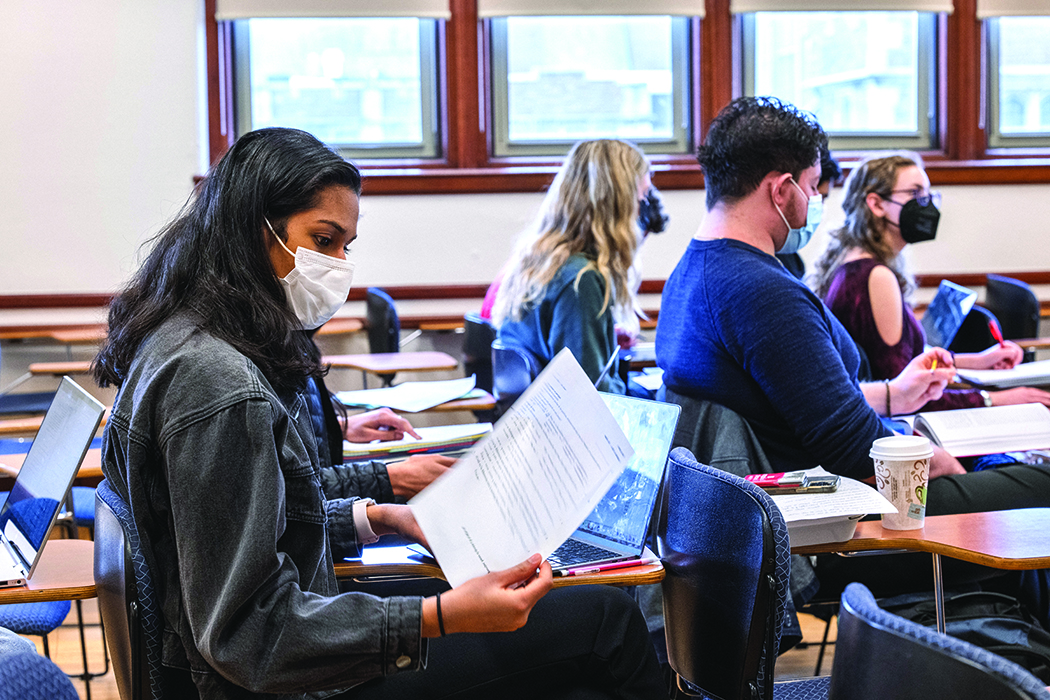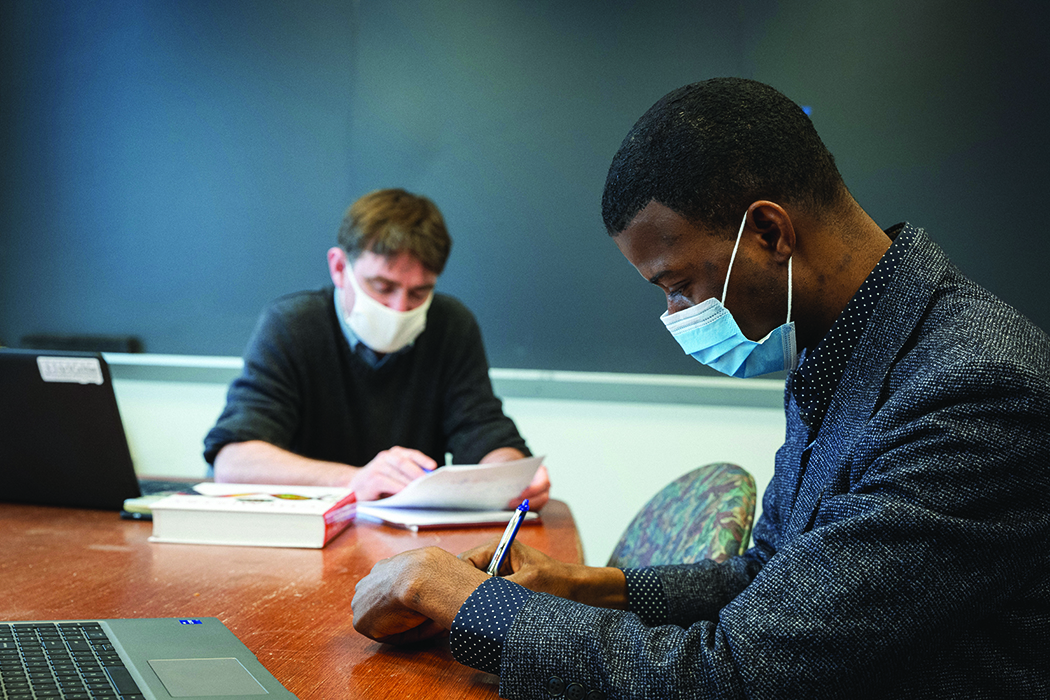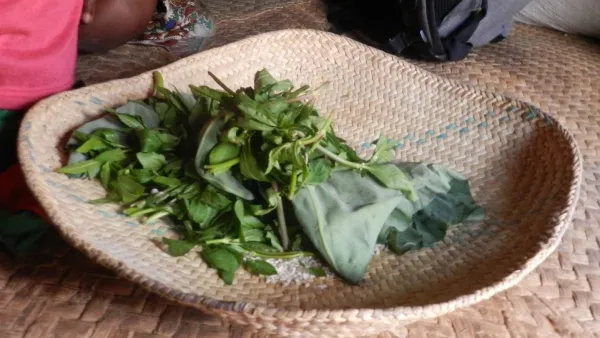The Assignment
Less than a year after setting up his office in Brookings Hall as the incoming dean of Arts & Sciences, complete with maps and photos from research expeditions around the world, Feng Sheng Hu voiced an audacious set of goals.
“Our aspiration is to become a global model of an arts and sciences school,” said Hu, who also serves as the Lucille P. Markey Distinguished Professor in Arts & Sciences. Hu described his vision for an elevated Arts & Sciences, an institution with a world-class research enterprise, a first-rate liberal arts college, and a diverse and inclusive community whose work is driven by creativity and convergence. Furthermore, he aimed to make bold progress in all these areas within the next decade.
Academia is no stranger to long-term planning, but Hu’s charge called for a shift in mindset – simultaneously broad and detailed, forward thinking and of the moment. Any progress toward the stated goals meant first addressing a series of staggeringly open-ended questions: What steps would raise Arts & Sciences’ already impressive standing? How should investments be allocated? Which overarching values would guide decisions?
With no syllabus or grant proposal at hand, this undertaking would require a different sort of guiding document. The school had been assigned the ultimate group project: the Arts & Sciences Strategic Plan.
Partnering Up
With most group projects, a handful of people collaborate to get the job done. Creating a 10-year plan for a 175-year-old institution with more than 40 academic units, however, necessitates a bit more brainpower and organizational infrastructure. To get the process started, leaders from across Arts & Sciences stepped in and teamed up to drive the effort.
Heading into the strategic planning process, Dean Hu noted the fortuitous timing and extensive institutional support for his school. In their current and previous roles, both Chancellor Andrew Martin and Provost Beverly Wendland have a history of advocating for the liberal arts. WashU had also recently embarked on a university-wide strategic planning process, offering opportunities for convergent collaboration.
As a preparatory step, Arts & Sciences engaged the services of a consulting group with extensive experience in higher education to help shape goals for each of the project’s five phases and conduct extensive analyses to help clarify where Arts & Sciences might make the most distinct impact in the years ahead.
With this support in place, Hu invited 12 faculty members to serve as the strategic planning steering committee. Carefully selected to represent areas across the humanities, natural sciences, and social sciences, as well as intentional overlap with the university-wide strategic planning effort, this group would meet regularly over the coming months to shape the Arts & Sciences plan.
For a project this large, still more leaders were needed. Hu solicited nominations for working groups focused on areas of critical importance, including undergraduate education and research, scholarship, and creative practice. Recommendations poured into the office. In the end, 20 faculty and staff members became co-leads of these groups, which were tasked with collecting and synthesizing feedback from the community at large.
Finally, with leaders at the ready and initial conversations about priorities and goals well underway, it was time for the research phase. For the next two months, the number of strategic plan contributors would spiral out to include hundreds of voices and thousands of opinions.
Research
When Arts & Sciences first interviewed consultants to help with the project, most firms offered to run only a few focus groups to gather community feedback – maybe as many as three or five.
“That’s when we would start telling them, ‘You don’t understand Arts & Sciences,’” said Ebba Segerberg, associate dean and chief of staff in Arts & Sciences. As project lead for the strategic planning process, Segerberg served as the main point of contact with both the consultants and the internal committees.

“We have all these different populations, and they all matter,” Segerberg said. “We realized that we needed to scale up that part of the project so that anybody in Arts & Sciences who wanted to take part in a focus group would have that chance.”
The result? Instead of a dozen conversations, the working groups hosted 56 hour-long discussions and took meticulous notes detailing all the concerns, hopes, points of pride, and ideas – big and small – that emerged. Some faculty advocated for formal interdisciplinary centers to encourage research collaboration; others thought a campus bar for socializing over beers would have the same effect. All opinions were welcome.
“I think one of the biggest goals was to hear from as many voices as possible across Arts & Sciences and really just get a feel for the current culture. Where are we falling short, and how can we improve? Where are we really successful, and how can we elevate those successes?” said Amanda Albert, one of the co-leads of the community and climate working group.
As an instructional specialist, Albert assists faculty and staff with course design. In a focus group with teaching faculty, she recalls discussions about how to ensure teaching and research productivity are equally valued. In focus groups with students in the natural and social sciences, she heard undergraduates discuss the strength of mentorship in Arts & Sciences and how that could be further improved with more opportunities for peer-to-peer learning.

“The students were really enthusiastic. I think they enjoy being Arts & Sciences students, and they were really excited to be a part of the conversation and a part of building something new and exciting for the school,” Albert said. It’s a sentiment she shares.
“I think the work that we’re doing now is really going to make an impact far, far into the future. And I’m really excited to have been a part of some of this foundational work and feeling hopeful about where we’re going,” she said.
As a co-lead for the graduate education working group, William Acree saw a number of items relevant to graduate students come out of the research phase and eventually into the plan itself – things like the need for better access and support for underrepresented students, more transdisciplinary connections across departments and programs, and expanded support for diverse professional outcomes.
“There are all sorts of ways where graduate education is threaded throughout this transformative vision for Arts & Sciences over the next decade,” said Acree, a professor of Spanish who also serves as dean’s fellow for graduate education initiatives in Arts & Sciences and as interim co-director of WashU’s Center for the Study of Race, Ethnicity & Equity. “Graduate student research in many ways is really the frontier of knowledge-making. They are effectively the next generation of scholars.”
In addition to all the material gathered in focus groups, an open online survey collected more than 2,000 comments from nearly 400 faculty, staff, students, and alumni. Huron conducted further one-on-one interviews with selected stakeholders, including university leadership and alumni from multiple eras. The trove of data was enormous.
“It was epic,” Segerberg recalled months later with a smile. “All that scheduling and data collection in a fairly compressed time frame – that did almost kill us,” she said, “but I’m proud that we did it. It fostered conversations and exchanges of ideas between people who don’t normally talk to each other. That was incredibly productive and rewarding, and also very fun and inspiring. A lot of great ideas came out of this process.”
Crunch Time
In the next phase of the project, what started as a free flow of information began to crystallize into recognizable priorities and action items.
“It was refreshing to hear the diverse opinions from incredibly smart faculty and staff across the various disciplines,” said Thomas Bakupog, a lecturer and director of the peer-led team learning program in chemistry, who served as co-lead of the undergraduate education working group. “Initially, it was a little bit of a struggle to find overlapping themes, but it all came together toward the end when we were synthesizing all the feedback from the various focus groups and surveys. At that point, it became apparent that we all wanted the same things for our undergraduate programs.”
For Bakupog’s group, those priorities included undergraduate preparation for post-college life and further commitments to first-generation and underrepresented students. With assistance from Huron, all four working groups waded through notes and survey results to identify such agreed-upon points. The lists were then passed on to the steering committee, which met several times to further distill the material and identify common themes. Eventually, the plan’s final shape began to emerge.
"This is a time for Arts & Sciences at WashU to rise in prominence and visibility for the benefit of the entire university."
- Andrew D. Martin,
Chancellor
Pen to Paper
“You can’t come out of this saying there’s an author or even two authors. There are many authors to the strategic plan – which is how it should be, right?” said Deanna Barch, chair and professor of psychological and brain sciences. Along with Abram Van Engen, professor of English and dean’s fellow for educational innovations and initiatives, Barch co-chaired the strategic planning steering committee and led the drafting of the final plan.
As with much work written by faculty and students alike, Barch and Van Engen found that the act of putting ideas into words helped clarify concepts and highlight remaining questions. The writing stage also brought into greater focus the broad significance of the plan. Beyond shaping the trajectory of Arts & Sciences and Washington University as a whole, the plan responds to St. Louis’s history, great strengths, struggles, and forward progress, as well as the ongoing global challenges that students and scholars in Arts & Sciences strive every day to understand and address.
Barch remembers one weekend early in the process when she and Van Engen spent hours emailing documents back and forth to each other, editing and refining along the way. “It was a very collaborative, iterative process,” she said. “I felt like we were partners in it, and we had a bunch of other partners to help us too, so that it wasn’t the voice of a single person. I really felt that a collective voice was emerging through feedback from the community and writing together.”
True to the collaborative nature of the project, initial drafts of the plan were treated as open books. Leadership welcomed commentary at two virtual town halls open to the entire Arts & Sciences community. The National Council, largely made up of alumni, weighed in. Hu held office hours to gather even more individualized commentary.
"This is a dynamic plan — it’s meant to change and grow with the community, even as it fosters the growth and change needed to make us a global model for a school of arts and sciences."
-Abram Van Engen
Like all group projects, through all the editing and refining, a deadline loomed. Dean Hu aimed to share the plan with the university at large by the end of 2021 – and the time had arrived.

Submitted
After all the planning and research and synthesis and writing and rewriting, on Dec. 6, 2021, Arts & Sciences presented its group project: A Transformative Decade: Convergence, Creativity, Community. The plan’s overall structure includes four key foundational areas, six strategic pillars, and eight inaugural signature initiatives.
The foundational areas lay the groundwork for any future development in Arts & Sciences, articulating critical elements identified in the research phase that must be enhanced and supported for any valuable progress to occur. The pillars arise from the foundations, highlighting areas in Arts & Sciences where investment and progress will be focused in the coming decade.
Finally, eight signature initiatives represent exciting, concrete projects proposed by the Arts & Sciences community that are moving from idea to reality. For example, an expanded Living Earth Collaborative will join Arts & Sciences with St. Louis institutions to promote biological research and environmental justice; a new Center for Quantum Leaps will place Arts & Sciences at the forefront of emerging quantum technologies; and TRIADS, the Transdisciplinary Institute in Applied Data Sciences, will leverage advanced computational resources to address challenges in the social sciences. The eight initiatives chart bold next steps for Arts & Sciences, ensuring the school’s continued impact as a leader in research and education.
“I knew this community was bursting with incredible ideas and phenomenal potential, and it’s thrilling to see our aspirations coalesce into a plan,” said Dean Hu. “This was a truly stellar effort, and we’ve articulated a world-class vision. But the most exciting work is yet to come.”
See our plan and share your thoughts.




